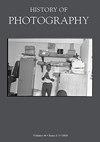使寮屋者人性化:紧急时期马来亚安置服务中的摄影
IF 0.2
2区 艺术学
0 ART
引用次数: 0
摘要
这篇文章探讨了马来亚殖民国家如何利用摄影来宣传所谓的重新安置成功——在马来亚紧急状态期间(1948年至60年),大约50万人被强行转移到营地,后来被称为“新村”。虽然这项研究探讨了“棚户区居民”这一种族化类别——即作为主要安置对象的中国农村人——在官方摄影中的反映方式,但它也认为有必要在20世纪50年代初东南亚摄影实践和消费的更广泛发展中考虑这种摄影。其中包括当地马来亚摄影师作为国家宣传机构的一部分所扮演的角色,以及同一时期人文主义摄影新闻作为一种表达方式的出现。在这样做的过程中,文章表明,马来亚的殖民摄影和商业摄影新闻之间的互动使现存的关于“殖民凝视”的文献变得复杂,同时也为战后早期摄影中殖民主义和人文主义之间的紧张关系的研究做出了贡献。本文章由计算机程序翻译,如有差异,请以英文原文为准。
Humanising the Squatter: Photography in the Service of Resettlement in Emergency-era Malaya
This article explores the ways in which photography was used by the colonial state in Malaya to promote the supposed success of resettlement – the counterinsurgency scheme through which around half a million people were forcibly moved into camps, later renamed ‘New Villages’, during the Malayan Emergency (1948–60). While this study engages with the ways in which the racialised category of the ‘squatter’ – that is, rural Chinese who were the main object of resettlement – was reflected in official photography, it also argues for the need to consider such photography within broader developments in photographic practice and consumption in Southeast Asia during the early 1950s. These include the role of local Malayan photographers as part of the state propaganda apparatus and the emergence of Humanist photojournalism as a mode of expression in the same period. In doing this, the article suggests that the interaction between colonial photography and commercial photojournalism in Malaya complicates the extant literature on the ‘colonial gaze’ while contributing to an emerging body of research on the tensions between colonialism and Humanism in early postwar photography.
求助全文
通过发布文献求助,成功后即可免费获取论文全文。
去求助
来源期刊
CiteScore
0.30
自引率
50.00%
发文量
23
期刊介绍:
History of Photography is an international quarterly devoted to the history, practice and theory of photography. It intends to address all aspects of the medium, treating the processes, circulation, functions, and reception of photography in all its aspects, including documentary, popular and polemical work as well as fine art photography. The goal of the journal is to be inclusive and interdisciplinary in nature, welcoming all scholarly approaches, whether archival, historical, art historical, anthropological, sociological or theoretical. It is intended also to embrace world photography, ranging from Europe and the Americas to the Far East.

 求助内容:
求助内容: 应助结果提醒方式:
应助结果提醒方式:


